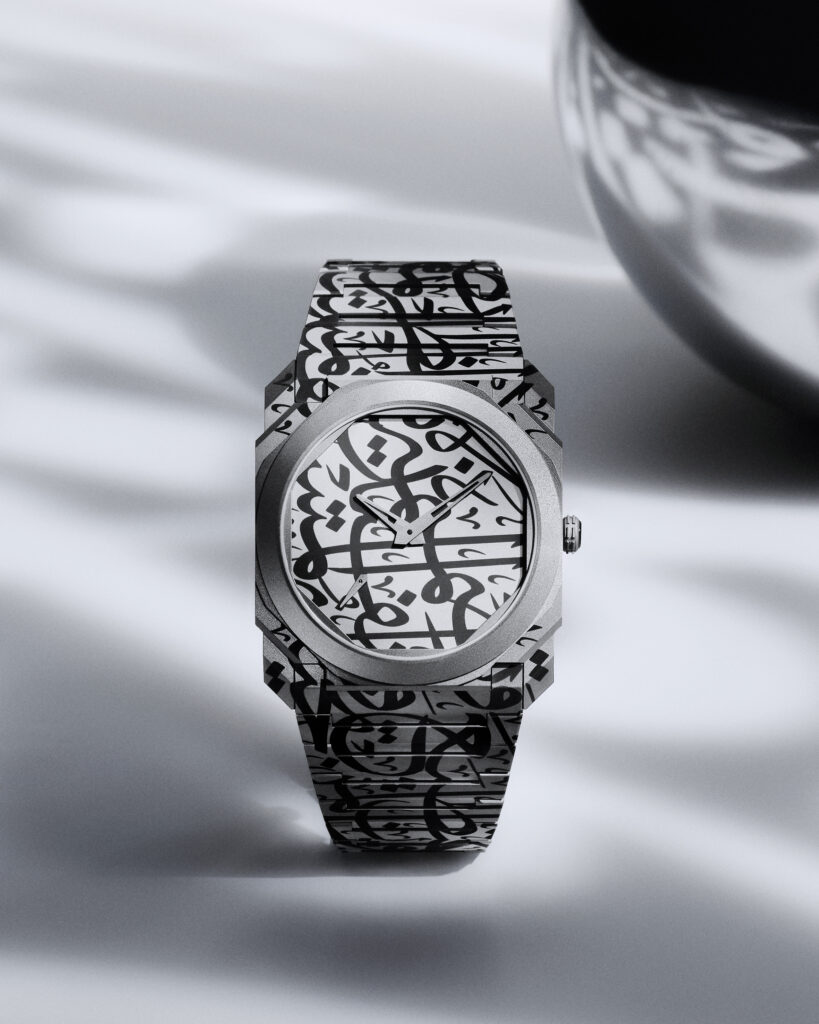News

Since its debut, Bvlgari’s Octo Finissimo has stood as a benchmark of radical elegance and uncompromising finesse, uniting Roman architectural codes with the highest expressions of Swiss horology. Beyond its technical achievements, the timepiece has evolved into a “blank canvas,” inviting artists to reinterpret its sleek, reductionist form. This openness has produced a succession of notable cross-cultural collaborations, from Korean artist Lee Ufan, to French artist Laurent Grasso, to Japanese architect Tadao Ando. The latest chapter in this artistic lineage is a partnership with Emirati artist Mattar Bin Lahej, unveiled at Dubai Watch Week 2025.
The limited-edition Mattar Bin Lahej x Octo Finissimo merges the artist’s refined calligraphic practice with the Maison’s most recognisable contemporary icon. At Dubai Watch Week, the Bvlgari booth drew considerable attention with a display window dedicated to the collaboration piece, framed by Mattar’s distinctive calligraphy mounted in metal over marble. The wider booth was conceived as an immersive environment, complete with a watchmaker’s bench, live demonstrations, and seating areas that brought guests closer to the intricacies of the craft.
Executed entirely in titanium, the watch is laser-engraved with Arabic calligraphy drawn from the words of His Highness Sheikh Mohammed bin Rashid Al Maktoum, Vice President and Prime Minister of the United Arab Emirates and Ruler of Dubai: “The future will be for those who can imagine, design, and implement it. The future does not wait, but it can be designed and built today.” True to the “blank canvas” ethos, the watch bears no Bvlgari branding or logo; the Octo’s identity is defined by form alone. Its geometry has become so ingrained in contemporary watch culture that, as Fabrizio notes, its silhouette needs no signature.
While many watchmakers incorporate Arabic aesthetics by simply replacing indices with Arabic-Indic numerals, including Bvlgari itself on earlier Octo Finissimo editions, the Maison no longer finds that approach compelling. For this collaboration, the intention was total immersion: Arabic lettering enveloping the entire watch, not only the dial or strap. As Fabrizio explains to ICON MENA, an event of Dubai Watch Week’s scale demanded ambition. “The size of this event is bigger and even more important every edition. The idea was to arrive with more than a new dial, it’s not something that is interesting for us anymore.”
Dubai Watch Week was the stage for the unveiling of the Octo, but it was also the place where the initial spark happened. “During the last Dubai Watch Week, I met Mattar for the first time,” Fabrizio recalls. The idea, however, had been gestating earlier. “During my previous trip in Dubai, someone started to talk about calligraphy, and I already had this project in mind, and I said, wow, why are they talking about calligraphy now with me? Maybe it’s because it’s something that is in the air.”

Recognising the cultural and technical precision required, Bvlgari quickly realised that such a project could not be attempted without expert partnership. “I asked the local team to find a way, because they told me ‘You cannot make it alone, because you’re going to make mistakes for sure. It’s something very precise. There are some masters of calligraphy here with a certification. So honestly, Fabrizio, we cannot make it alone.’”
This is where Mattar entered the picture, almost immediately. “And they found immediately the connection with Mattar because he’s the artist behind the Museum of the Future’s calligraphy and he created these amazing artworks.” Their first meeting took place at none other than the Museum of the Future, followed by a working session in Mattar’s studio, and encounters that set the tone for a fluid creative exchange. “He explained everything, and after, we had a meeting in his own studio. We started immediately to talk about the sketches, the products, the piece of art.”
What followed was an unexpectedly seamless collaboration, anchored in shared aesthetic language. “He plays a lot with the calligraphy elements, like sculpture, three-dimensional, and evolution. Honestly, it was very easy. There are some collaborations that are not as easy. With Mattar, it was really simple.”
![]()
Even with his long-standing fascination for the script, Fabrizio was well aware that Arabic calligraphy required a master’s hand, though that did not stop him from experimenting early on. “I remember very well when I showed some of the sketches to Mattar. Mattar told me, Fabrizio, this is not even Arabic! What is this? I don’t know. We took it on the internet and we just put it to have an idea. This is not Arabic. Maybe a mix of Persian, Iranian and something like that.”
A project of this magnitude demanded not only artistic synergy, but also absolute technical precision. The fully engraved titanium exterior required Bvlgari to produce the watch entirely in-house, utilising the Manufacture’s specialised laser-engraving technology. To achieve uninterrupted calligraphic flow across case and bracelet, the team first received Mattar’s drawing, then translated it into highly complex technical schematics. “It’s something that takes a lot of time because it’s micro dots. It’s not something that is like a marker.” Each bracelet link was engraved individually before assembly, a process requiring extraordinary care.